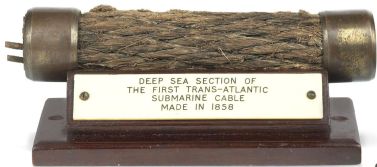An important aspect of our study of the reformed Commons is the degree to which representatives of science and industry were incorporated into the legislature during a period of great economic expansion. Our MP of the Month was among those who entered Parliament from a scientific and engineering background. A young pioneer of new technology, Charles Tilston Bright was responsible for laying the first Atlantic telegraph cable.

Sir Charles Tilston Bright
Descended from an ‘old Yorkshire family’, Bright was born at Wanstead in Essex, the youngest son of Brailsford Bright, a manufacturing chemist and merchant. From 1840 he was educated at the Merchant Taylors’ School, where he demonstrated an aptitude for chemistry and the study of electricity. By 1848, however, his father was bankrupt and being unable to attend university the 15-year-old Bright joined his elder brother, Edward, at the newly-founded Electric Telegraph Company. Working under the direction of William Fothergill Cooke (1806-79), a pioneer of electric telegraphy, he was first employed in the construction of telegraph lines for various railways in northern England and Scotland. In 1852 he was appointed chief engineer to the Magnetic Telegraph Company and in conjunction with his brother, the company’s manager, he patented a series of inventions, including systems for fault testing, relaying electric currents, protecting submarine cables and type-printing.
 In 1853 he laid down the first deep water cable which linked Port Patrick in Scotland with Donaghadee in Ireland, and in 1856 he entered into an agreement to develop telegraphic communication between Newfoundland and Ireland under the auspices of the Atlantic Telegraph Company. As engineer-in-chief, he was responsible for superintending the laying of the 2,000-mile-long cable. Work began in June 1857 and after two failed attempts the task was completed on 5 August 1858, Bright’s report on the expedition being published in Illustrated London News, 28 Aug. 1858. Although only 26 years of age, he was knighted for his services by the Irish viceroy, although it would be another eight years before the Atlantic telegraph was brought into full commercial use.
In 1853 he laid down the first deep water cable which linked Port Patrick in Scotland with Donaghadee in Ireland, and in 1856 he entered into an agreement to develop telegraphic communication between Newfoundland and Ireland under the auspices of the Atlantic Telegraph Company. As engineer-in-chief, he was responsible for superintending the laying of the 2,000-mile-long cable. Work began in June 1857 and after two failed attempts the task was completed on 5 August 1858, Bright’s report on the expedition being published in Illustrated London News, 28 Aug. 1858. Although only 26 years of age, he was knighted for his services by the Irish viceroy, although it would be another eight years before the Atlantic telegraph was brought into full commercial use.

Transatlantic cable between Newfoundland and Ireland
Now at the head of his profession, Bright went into partnership and superintended further submarine cable-laying in the Baltic and Mediterranean. In 1864 he completed a line to India via the Persian Gulf and in November 1865 raised the issue of extending the cable to Australia and China. By then he had accepted an invitation to stand as a Liberal candidate for the maritime borough of Greenwich, where many of his telegraphic cables had been manufactured and where he was a household name. He was returned after a tight contest at which he was able to exploit his business contacts to bring in useful Conservative votes. An opponent of the ballot, he was by ‘no means a Radical’, but still enjoyed the company of John Bright, with whom he regularly played billiards at the Reform Club. A loyal back-bencher, he rarely spoke in debate, although his observations were always ‘concise and to the point’ and confined to issues he knew thoroughly. Consequently, he sat on the select committee inquiry into the operation of postal and telegraphic communication between the United Kingdom and India, and took an understandable interest in the Telegraph Purchase and Regulations Act of 1868, under which all of Britain’s inland telegraphs were acquired by the Post Office. However, the amount of time he spent working abroad eventually caused discontent within his constituency, and he retired at the 1868 general election, his place being taken by William Gladstone, who had lost his seat for South Lancashire.
Freed from parliamentary commitments, Bright personally superintended the laying of nearly 4,000 miles of cable in the Caribbean, including one that connected Florida to Cuba. However, by 1871 malaria had so weakened his health that he returned to Europe and turned his attention to mining for copper and lead. In 1881 he was one of the British commissioners at the Electrical Exhibition in Paris, for which the French government awarded him the Légion d’Honneur. He became president of the Society of Telegraph Engineers in 1887, by which time he was widely recognised as one of the chief pioneers of the electrical industry.
Described as ‘genial and clubbable’ and ‘generous to the point of extravagance’, Bright never became particularly wealthy and in May 1888 he died suddenly of apoplexy at his brother’s home near Erith in Kent. His youngest son, Charles Bright (1863-1937), also became an authority on submarine telegraphy and was himself knighted in 1919.
Further reading:
A. C. Lynch, ‘Bright, Sir Charles Tilston’, Oxf. DNB, vii. 616-7.
E. B. Bright & C. Bright, The Life Story of the late Sir Charles Tilston Bright, 2 vols. (1899).
Illustrated London News, 4 Sept. 1858, 19 May 1888.

Pingback: Happy New Year from the Victorian Commons! | The Victorian Commons
Pingback: The MP who founded a town: Sir Peter Hesketh-Fleetwood (1801-66) | The Victorian Commons